 According to BOM (Bureau of meteorology) this year Brisbane has had a record run of 46 days at 30ºC or above from early January 2019 to late February 2019. The start to this summer has been similarly hot; and while we may be splashing about in the pool and hitting the beaches to cool off – what about our pets?
According to BOM (Bureau of meteorology) this year Brisbane has had a record run of 46 days at 30ºC or above from early January 2019 to late February 2019. The start to this summer has been similarly hot; and while we may be splashing about in the pool and hitting the beaches to cool off – what about our pets?
While some dogs may like to take a dip with us to cool off – how do we keep them cool when they aren’t swimming? If they don’t like to swim? Or if we aren’t home?
Heat stress, also referred to as heat stroke or hyperthermia can become very serious and even life threatening very quickly; not just for us, but for our pets too. Unfortunately our pets cannot tell us with words if they are uncomfortable or unwell; it is up to us to know the signs.
Both cats and dogs are unable to sweat to cool off as effectively as us humans due to having very few sweat glands in comparison. Dog and cats can sweat only from their paws and noses; they rely heavily on panting to cool down.
Heat stress can be caused by several things and as temperatures become higher, risk of heat stress increases, some factors that put your animal at risk are below:
• Animals trapped in an area with no ventilation (Cars, hot houses, sheds, etc), animals with no shade, or no water are at a high risk.
• Excessive exercise is also a big risk, though you might often think that they would stop if it was going to be harmful to them, it is unfortunately not the case – it is up to us to regulate their exercise, restricting when necessary and avoiding exercise in the hotter parts of the day (usually but not restricted to between 11am and 6pm). It is also important to always check that the ground is not too hot for their paws – sometimes we forget because we are wearing shoes! Remember the 5 second rule – if you cannot hold the back of your hand on the pavement or bitumen for 5 seconds or more, then it is too hot for them to walk on!
• The health of an animal can also be a contributing factor, the very young and the very old have a higher risk, as well as animals with respiratory disease and/ or heart disease. Animals that have recently been ill, especially with vomiting or diarrhoea which cause dehydration are also at a higher risk.
• Certain breeds have an increased risk, like brachycephalic breeds (flat faced) such as Persian cats, Himalayan cats, Pugs, French bull dogs and mastiff breeds to name a few. Don’t forget the breeds with long hair too!
Signs of heat stress can vary slightly between cats and dogs, but are quite similar; signs of heat stress may include all or some of the following:
• Agitation/ restlessness (cats may pace)
• Excessive grooming in cats
• Panting
• Feel hot to touch
• May have unusually bright pink ears and/ or paws
• Drooling/ salivating
• Red or pale gums
• Sticky or dry gums
• Bright red tongue
• Vomiting or diarrhoea
• They may be confused or unfocussed
• Dizzy or unstable on their feet
• Lethargic and/ or weak
• Muscle tremors
• Seizures
• Collapse
 A dog’s normal temperature ranges from 37.5ºC to 39.3ºC and a cat’s normal temperature is 38.0ºC to 39.3ºC. A rectal temperature over 40.0ºC requires action (cooling!) and a temperature over 41.0ºC is a serious emergency.
A dog’s normal temperature ranges from 37.5ºC to 39.3ºC and a cat’s normal temperature is 38.0ºC to 39.3ºC. A rectal temperature over 40.0ºC requires action (cooling!) and a temperature over 41.0ºC is a serious emergency.
If you suspect that your pet is suffering from heat stress it is important that you take immediate action!
• If they are collapsed, unstable, have muscle tremors or seizures please drape wet towels on the animal and/ or wrapped ice-bricks (avoiding direct contact with skin/ fur) and call the vet immediately – then get driving to the vet!
Otherwise…
• Remove them from the hot area if you have not already done so.
• Spritz or wet down fur with tepid water. DO NOT USE ICE-COLD WATER, this can make your pet worse as the extreme cold constricts blood vessels that normally help direct heat away from the body’s core. You can also use wet towels/ cloths to help cooling as well as a fan. If using a hose outside (for larger dogs), always check the temperature of the water first, as hoses left in the hot sun can hold scalding-hot water.
• Ice bricks wrapped in towels and placed in groin area and under front legs can help (remembering to avoid placing ice directly onto animal).
• Call your vet! Even if they seem ok once you have cooled them down it is a good idea to get them checked by a vet. The vet will do a full assessment to make sure that they are fully recovered and that no lasting damage has been caused. Animals may need further cooling and/ or intravenous fluids, more severe cases may require additional treatment such as oxygen therapy, medication and/ or sedation.
How do we prevent our pets from getting heat stress in the first place?
• Keeping an eye or ear out for the weather report, if you know we are coming up to some warm weather it is easier to prepare for it.
• Regardless of whether it is going to be hot, all animals should always have access to plenty of fresh drinking water. If you know that your dog is fond of splashing about or sitting in their water bowl, make sure they have more than one water bowl and/ or look into getting a small pool for them (clam shells/ kids plastic sand pits often make good doggie pools).
• Try to keep animals inside in the hot parts of the day (if your house is cool and well ventilated).
• If it is going to be hot for inside pets – can you leave your air-conditioning on inside? If not, can you leave a fan going? Do they have access to tiled areas? Often cats and dogs will seek out cool areas such as tiles to lie on. Can you pull blinds closed to keep the house dark and cool?
• Make sure outside pets have adequate shade and or a cool area that they can escape to.
• Avoid exercising or vigorous play on especially hot days. In warmer weather in general it is a good idea to only exercise them early in the morning or later in the evening.
• Ice cubes/ ice treats are fine to give your dogs as a treat to keep them cool, as long as the cubes are an appropriate size (are not a choking hazard). A nice treat can be made by freezing chicken broth and veggies in an appropriately sized container for your dog.
We hope you and your pets can enjoy a relaxing summer and stay nice and cool! If you have any questions or concerns about your pet, we are only a phone call away!



